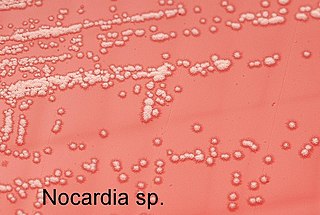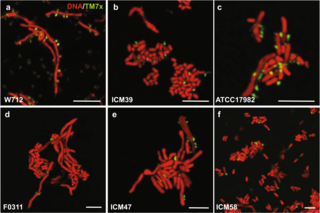The Aquificota phylum is a diverse collection of bacteria that live in harsh environmental settings. The name Aquificota was given to this phylum based on an early genus identified within this group, Aquifex, which is able to produce water by oxidizing hydrogen. They have been found in springs, pools, and oceans. They are autotrophs, and are the primary carbon fixers in their environments. These bacteria are Gram-negative, non-spore-forming rods. They are true bacteria as opposed to the other inhabitants of extreme environments, the Archaea.

Actinomyces is a genus of the Actinomycetia class of bacteria. They all are Gram-positive and facultatively anaerobic, growing best under anaerobic conditions. Actinomyces species may form endospores, and while individual bacteria are rod-shaped, Actinomyces colonies form fungus-like branched networks of hyphae. The aspect of these colonies initially led to the incorrect assumption that the organism was a fungus and to the name Actinomyces, "ray fungus".

Nocardia is a genus of weakly staining Gram-positive, catalase-positive, rod-shaped bacteria. It forms partially acid-fast beaded branching filaments. It contains a total of 85 species. Some species are nonpathogenic, while others are responsible for nocardiosis. Nocardia species are found worldwide in soil rich in organic matter. In addition, they are oral microflora found in healthy human gingiva, as well as periodontal pockets. Most Nocardia infections are acquired by inhalation of the bacteria or through traumatic introduction through openings in epithelial barriers.

The Bifidobacteriaceae are the only family of bacteria in the order Bifidobacteriales. According to the 16S rRNA-based LTP release 106 published by 'The All-Species Living Tree' Project, the order Bifidobacteriales is a clade nested within the suborder Micrococcineae, also the genus Bifidobacterium is paraphyletic to the other genera within the family, i.e. the other genera are nested within Bifidobacterium.
The Caryophanaceae is a family of Gram-positive bacteria. In 2020, the now defunct family Planococcaceae was merged into Caryophanaceae to rectify a nomenclature anomaly. The type genus of this family is Caryophanon.

Streptomycetaceae is a family of the class Actinomycetota, making up the monotypic order Streptomycetales. It includes the important genus Streptomyces. This was the original source of many antibiotics, namely streptomycin, the first antibiotic against tuberculosis.

The Pseudonocardiaceae are a family of bacteria in the order Actinomycetales and the only member of the suborder Pseudonocardineae.

Saccharibacteria, formerly known as TM7, is a major bacterial lineage. It was discovered through 16S rRNA sequencing.
Adlercreutzia is a genus in the phylum Actinomycetota (Bacteria).
There are several models of the Branching order of bacterial phyla, one of these was proposed in 1987 paper by Carl Woese.
Beutenbergiaceae is an Actinomycete family.
Thermomonosporaceae is a family of bacteria that share similar genotypic and phenotypic characteristics. The family Thermomonosporaceae includes aerobic, Gram-positive, non-acid-fast, chemo-organotrophic Actinomycetota. They produce a branched substrate mycelium bearing aerial hyphae that undergo differentiation into single or short chains of arthrospores. All species of Thermomonosporaceae share the same cell wall type, a similar menaquinone profile in which MK-9(H6)is predominant, and fatty acid profile type 3a. The presence of the diagnostic sugar madurose is variable, but can be found in most species of this family. The polar lipid profiles are characterized as phospholipid type PI for most species of Thermomonospora, Actinomadura and Spirillospora. The members of Actinocorallia are characterized by phospholipid type PII.
Gordonia is a genus of gram-positive, aerobic, catalase-positive bacterium in the Actinomycetota, closely related to the Rhodococcus, Mycobacterium, Skermania, and Nocardia genera. Gordonia bacteria are aerobic, non-motile, and non-sporulating. Gordonia is from the same lineage that includes Mycobacterium tuberculosis. The genus was discovered by Tsukamura in 1971 and named after American bacteriologist Ruth Gordon. Many species are often found in the soil, while other species have been isolated from aquatic environments. Some species have been associated with problems like sludge bulking and foaming in wastewater treatment plants. Gordonia species are rarely known to cause infections in humans.
The Actinobacterial Phage Holin (APH) Family is a fairly large family of proteins between 105 and 180 amino acyl residues in length, typically exhibiting a single transmembrane segment (TMS) near the N-terminus. A representative list of proteins belonging to the APH family can be found in the Transporter Classification Database.
The Coriobacteriia are a class of Gram-positive bacteria within the Actinomycetota phylum. Species within this group are nonsporulating, strict or facultative anaerobes that are capable of thriving in a diverse set of ecological niches. Gordonibacter species are the only members capable of motility by means of flagella within the class. Several species within the Coriobacteriia class have been implicated with human diseases that range in severity. Atopobium, Olsenella, and Cryptobacterium species have responsible for human oral infections including periodontitis, halitosis, and other endodontic infections. Eggerthella species have been associated with severe blood bacteraemia and ulcerative colitis.
The Pectobacteriaceae are a family of Gram-negative bacteria which largely consist of plant pathogens. This family is a member of the order Enterobacterales in the class Gammaproteobacteria of the phylum Pseudomonadota. The type species of this family is Pectobacterium.

The Hafniaceae are a family of Gram-negative bacteria. This family is a member of the order Enterobacterales in the class Gammaproteobacteria of the phylum Pseudomonadota. Genera in this family include the type genus Hafnia, along with Edwardsiella and Obesumbacterium.
The Eggerthellaceae are a family of Gram-positive, rod- or coccus-shaped Actinomycetota. It is the sole family within the order Eggerthellales.
Natrialbales is an order of halophilic, chemoorganotrophic archaea within the class Haloarchaea. The type genus of this order is Natrialba.
Haloferacales is an order of halophilic, chemoorganotrophic or heterotrophic archaea within the class Haloarchaea. The type genus of this order is Haloferax.







